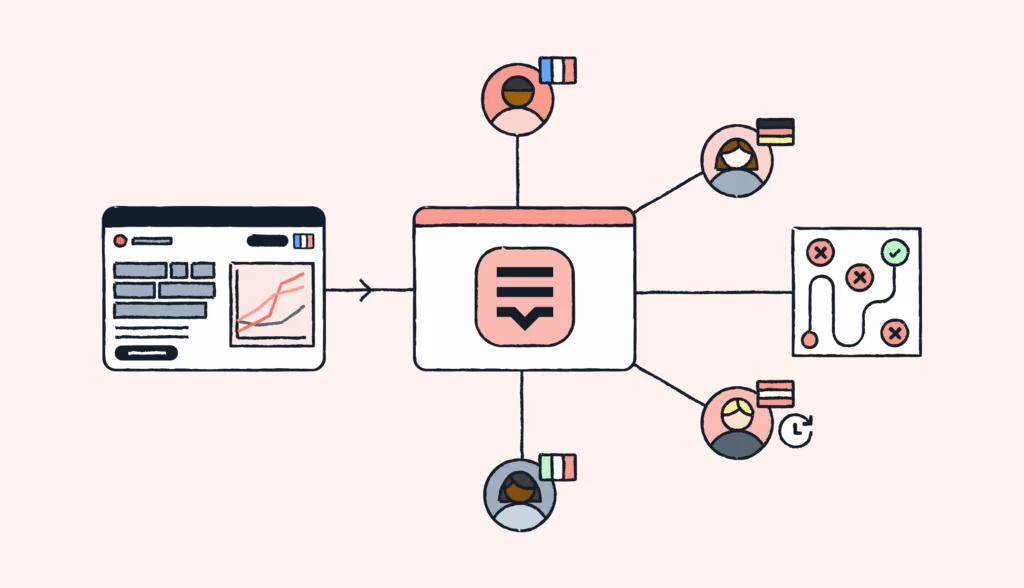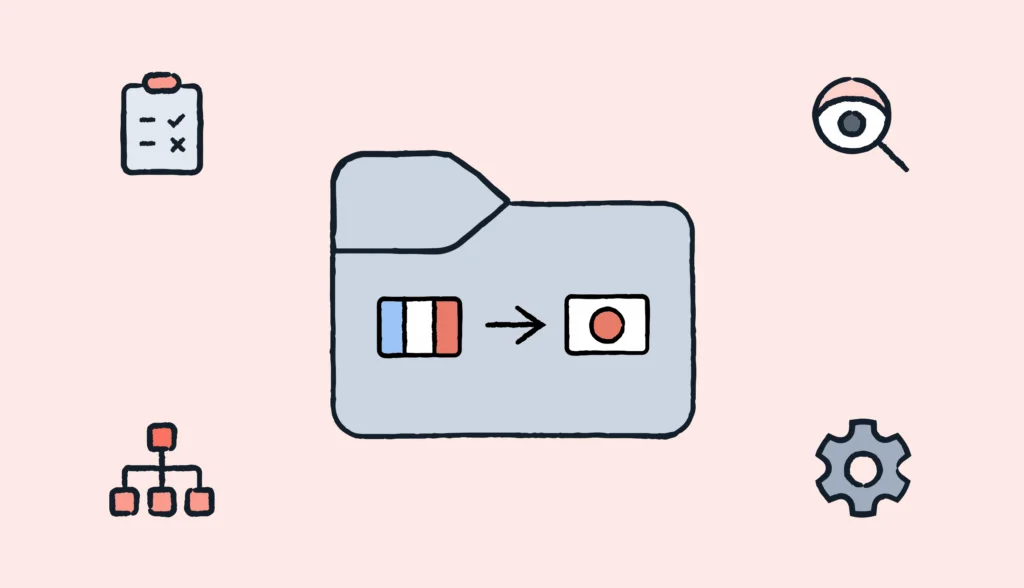Whether you are experienced in localization or not, some terms may still raise a question. With so many important acronyms, abbreviations, and phrases in the world of localization and localization management, we decided to compile a comprehensive glossary of translation and localization terms.
Read on to learn more about the most common terminology related to localization and translation.
Agile localization
Agile localization is a set of practices to merge localization and translation into an agile product development cycle. It syncs your localization process with your development process so they operate simultaneously. Read more about agile localization here.
API
API stands for Application Programming Interface, a software intermediary that makes it possible for applications to interact with each other and share data. Check out the Lokalise API.
CAT
CAT stands for Computer-Assisted Translation and is the process of using software to make translation more efficient and accurate. (Sadly, it has nothing to do with cats.) CAT tools typically include translation memory, concordance, import/export, and post-production features.
Collaborative translation
Collaborative translation is when a group of people works together on a translation project in a collaborative online workspace. The goal is to improve quality and cut total translation time. Lokalise offers collaborative translation features.
Concordance search
Concordance searching is searching for words or phrases within a translation memory database. This process helps translators produce quicker, more accurate translations.
Content Management system
A content management system (CMS) is a software application that helps users who don’t know HTML better manage their website content. Popular CMS tools include WordPress, HubSpot, Droopal, and Joomla. Check out our CMS integrations.
Continuous localization
Continuous localization is a subset of agile localization where the localization process runs autonomously and seamlessly along the product development process. It eliminates the manual process of localization (string upload/download, committing changes to version control, sending files, etc.) as much as possible.
DNT
DNT stands for Do Not Translate. This acronym is usually used for brand names, trademarks, and other important phrases that should remain in their source language.
Fuzzy matching
Fuzzy matching is a technique used by CAT tools to look for phrases and sequences of words within a translation memory database. It works with matches that are not 100% exact, and it helps save money and time with translations, especially if companies are translating content on a regular basis.
101% matching
101% matching is when the text of a string matches the text of a string and the context in the translation memory.
GILT
GILT is an acronym that stands for globalization, internationalization, localization, and translation.
Globalization
Globalization is the process by which businesses or other organizations develop international influence or start operating on an international scale. Globalization is also called g11n.
Glossary
A localization glossary is a list of terms and definitions used for a specific localization project. It explains what the terms mean, how to translate them, and whether to translate them at all (as some brand and feature names may be DNT).
GUI
GUI stands for Graphical User Interface. It’s a form of user interface that allows users to interact with electronic devices through graphical icons and visual indicators.
In-context translation
In-context translation allows translators to see the environment in which the word or sentence is used. It’s basically a mechanism that shows the source text alongside other content or graphical elements such as the background image or product screenshots. Lokalize offers in-context features.
International SEO
International SEO is the practice of optimizing your website to rank higher in search engines for users in different countries and languages. By taking a strategic approach to international SEO, you can expand your reach to a global audience and drive more traffic and sales to your website. Learn more about the key techniques and steps for crafting an international SEO strategy to unlock the full potential of your online business.
Internationalization
Internationalization is the process of designing and developing a software or mobile application product to allow it to be easily localized for its target audiences in different cultures, regions, and languages. Internationalization is also called i18n.
Keys
Keys are unique identifiers used for representing text in your code, files, or elsewhere. When you compose a language-specific version of your product, these identifiers are replaced with the corresponding values in a particular language. In some file formats, such as .po, base language values serve as keys.
Language code
Language code is code that assigns letters or numbers as identifiers or classifiers for languages. For example, ES = Spanish.
Language pair
A language pair refers to languages in which a translator or interpreter can provide translation services.
Language service provider
A language service provider, also called an LSP, is an organization or business that supplies language services like translation, localization, or interpretation. Read more about how to choose the right language service provider here.
Literal translation
A literal translation is a translation that closely follows the phrasing, order, and sentence construction of the source language. This type of translation typically has bad quality because different languages also have a different context, inflection, and meaning.
Locale
Locale refers to the combination of a language and specific geographic region (usually a country) where terminology is adapted for specific content and design.
Localization
Localization is the adaptation of a software or mobile application product to meet the language, culture, and other requirements of a locale. Localization (unlike translation) also includes time and date differences, currency, symbols, and cultural specificities. Read more about localization here.
Localization software
Localization software tools aim to minimize manual and repetitive localization work for software development teams. Lokalise is a localization software, and it can help you significantly improve your localization workflow management.
Localization testing
Localization testing is the process of verifying and validating the localization done for a software or mobile application product.
Machine translation
Machine translation (MT) is a software-based process that translates content from one language to another without human intervention. While it helps with quick translations, it doesn’t produce the same quality as manual, human translations.
Markup language
Markup language refers to the different web languages (including HTML, XML, and XHTML) that specify the formatting, layout, and style of website content. It uses <tags> before and afterwords and phrases to specify formatting. For example, <b> this phrase is bold <b>. When translating, the content inside the tags is translated.
Multilingual workflow
A multilingual workflow is the automation of business processes by managing multilingual content. This is usually done using a translation management system, machine translation, and translation memory.
Post-edited machine translation
When a translation is made by software, it can (and should) be reviewed by human translators — which turns machine translation into post-edited machine translation. This process captures the efficiency of MT while ensuring the accuracy of manual translation.
Proofreading
Proofreading is checking a translated text to identify and correct spelling, grammar, syntax, coherency, and other errors.
Pseudo-localization
Pseudo-localization is the process of faking the translation of software or web applications before starting to officially localize the product. It’s used to verify that the user interface is capable of containing the translated strings (length) and to discover possible internationalization issues.
Quality assurance
Quality assurance (QA) is the process of determining whether a product or service meets specified localization and internationalization requirements.
RTL
RTL stands for Right to Left and is a specific term for languages that are written and read in the right to left direction. Examples include Hebrew, Arabic, Urdu, and Persian.
SDK
SDK stands for Software Development Kit. An SDK (or dev kit) provides a set of tools, libraries, relevant documentation, code samples, processes, and guides that allow developers to create software applications on a specific platform.
Segment
A segment is a phrase, sentence, or piece of text that represents a cognitive unit and is used when searching for a match in a translation memory.
Segmentation
Segmentation is the process of splitting translations into smaller, relevant chunks. It makes translators more efficient, translation memory richer and the experience better when localizing longer texts.
Simship
Simship is short for simultaneous shipping. It refers to when products or content are released in their domestic market and foreign market(s) at the same time.
Source file
A source file is a file that contains the original strings that will be used as a source language for translations.
Source language
The source language is the original language of a text that is translated into another language.
Target language
The target language is the language into which text is translated.
Transcreation
Transcreation is the process of re-developing or adapting content from one culture to another while transferring its meaning and maintaining its intent, style, and voice. This process often required skilled translators fluent in the source and target languages and need multiple rounds of proofreading.
Translatability
Translatability is the degree to which a text can be translated into another language.
Translation
Translation is the act of converting the meaning of a text from one language into another, accurately reproducing not only the meaning but also the tone. Translation is also referred to as t9n. Lokalise offers professional translation services.
Translation management system
A translation management system (TMS) is a program that makes localization faster, easier, and more efficient. It’s very important to choose the right TMS for your business to help make the localization process easier and more efficient. Read more about translation management systems here.
Translation memory
A translation memory is a database that stores all your previous translations and will suggest translations for future projects to save time.
Translation memory leverage
Translation memory leverage is the amount of text a given source has previously stored in its translation memory. It gives a better estimation of how much new translation work needs to be done.
XLIFF
XLIFF stands for XML Localization Interchange File Format. A single interchange file has to be provided in a format that can be understood by any localization provider. XLIFF file format is the preferred way of exchanging data in XML format in the translation industry.
XML
XML stands for eXtensible markup language and is the metadata language used to describe other markup languages.





